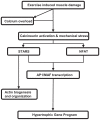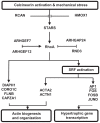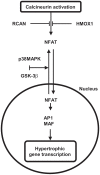Eccentric exercise activates novel transcriptional regulation of hypertrophic signaling pathways not affected by hormone changes
- PMID: 20502695
- PMCID: PMC2872670
- DOI: 10.1371/journal.pone.0010695
Eccentric exercise activates novel transcriptional regulation of hypertrophic signaling pathways not affected by hormone changes
Abstract
Unaccustomed eccentric exercise damages skeletal muscle tissue, activating mechanisms of recovery and remodeling that may be influenced by the female sex hormone 17beta-estradiol (E2). Using high density oligonucleotide based microarrays, we screened for differences in mRNA expression caused by E2 and eccentric exercise. After random assignment to 8 days of either placebo (CON) or E2 (EXP), eighteen men performed 150 single-leg eccentric contractions. Muscle biopsies were collected at baseline (BL), following supplementation (PS), +3 hours (3H) and +48 hours (48H) after exercise. Serum E2 concentrations increased significantly with supplementation (P<0.001) but did not affect microarray results. Exercise led to early transcriptional changes in striated muscle activator of Rho signaling (STARS), Rho family GTPase 3 (RND3), mitogen activated protein kinase (MAPK) regulation and the downstream transcription factor FOS. Targeted RT-PCR analysis identified concurrent induction of negative regulators of calcineurin signaling RCAN (P<0.001) and HMOX1 (P = 0.009). Protein contents were elevated for RND3 at 3H (P = 0.02) and FOS at 48H (P<0.05). These findings indicate that early RhoA and NFAT signaling and regulation are altered following exercise for muscle remodeling and repair, but are not affected by E2.
Conflict of interest statement
Figures







Similar articles
-
17β-estradiol attenuates exercise-induced neutrophil infiltration in men.Am J Physiol Regul Integr Comp Physiol. 2011 Jun;300(6):R1443-51. doi: 10.1152/ajpregu.00689.2009. Epub 2011 Mar 2. Am J Physiol Regul Integr Comp Physiol. 2011. PMID: 21368271 Clinical Trial.
-
Protein kinase CK2-dependent phosphorylation of the human Regulators of Calcineurin reveals a novel mechanism regulating the calcineurin-NFATc signaling pathway.Biochim Biophys Acta. 2013 Oct;1833(10):2311-21. doi: 10.1016/j.bbamcr.2013.05.021. Epub 2013 Jun 1. Biochim Biophys Acta. 2013. PMID: 23732701
-
Modulation of RhoA-Rho kinase-mediated Ca2+ sensitization of rabbit myometrium during pregnancy - role of Rnd3.J Physiol. 2003 Oct 15;552(Pt 2):403-13. doi: 10.1113/jphysiol.2003.047738. J Physiol. 2003. PMID: 14561824 Free PMC article.
-
Effect of moderate acute exercise on expression of mRNA involved in the calcineurin signaling pathway in human skeletal muscle.IUBMB Life. 2003 Jul;55(7):409-13. doi: 10.1080/15216540310001592825. IUBMB Life. 2003. PMID: 14584592
-
Transcriptional adaptations following exercise in thoroughbred horse skeletal muscle highlights molecular mechanisms that lead to muscle hypertrophy.BMC Genomics. 2009 Dec 30;10:638. doi: 10.1186/1471-2164-10-638. BMC Genomics. 2009. PMID: 20042072 Free PMC article.
Cited by
-
Transcriptional profile in rat muscle: down-regulation networks in acute strenuous exercise.PeerJ. 2021 Apr 2;9:e10500. doi: 10.7717/peerj.10500. eCollection 2021. PeerJ. 2021. PMID: 33859869 Free PMC article.
-
Time course of gene expression during mouse skeletal muscle hypertrophy.J Appl Physiol (1985). 2013 Oct 1;115(7):1065-74. doi: 10.1152/japplphysiol.00611.2013. Epub 2013 Jul 18. J Appl Physiol (1985). 2013. PMID: 23869057 Free PMC article.
-
Identification of a conserved set of upregulated genes in mouse skeletal muscle hypertrophy and regrowth.J Appl Physiol (1985). 2015 Jan 1;118(1):86-97. doi: 10.1152/japplphysiol.00351.2014. Epub 2014 Nov 13. J Appl Physiol (1985). 2015. PMID: 25554798 Free PMC article.
-
Repeated bouts of fast velocity eccentric contractions induce atrophy of gastrocnemius muscle in rats.J Muscle Res Cell Motil. 2015 Oct;36(4-5):317-27. doi: 10.1007/s10974-015-9426-0. Epub 2015 Oct 17. J Muscle Res Cell Motil. 2015. PMID: 26476829
-
The STARS signaling pathway: a key regulator of skeletal muscle function.Pflugers Arch. 2014 Sep;466(9):1659-71. doi: 10.1007/s00424-014-1475-5. Epub 2014 Feb 21. Pflugers Arch. 2014. PMID: 24557714 Review.
References
-
- Favier FB, Benoit H, Freyssenet D. Cellular and molecular events controlling skeletal muscle mass in response to altered use. Pflugers Arch. 2008;456:587–600. - PubMed
-
- Heineke J, Molkentin JD. Regulation of cardiac hypertrophy by intracellular signalling pathways. Nat Rev Mol Cell Biol. 2006;7:589–600. - PubMed
-
- Wennerberg K, Rossman KL, Der CJ. The Ras superfamily at a glance. J Cell Sci. 2005;118:843–846. - PubMed
-
- Bassel-Duby R, Olson EN. Signaling pathways in skeletal muscle remodeling. Annu Rev Biochem. 2006;75:19–37. - PubMed
-
- Armstrong RB. Initial events in exercise-induced muscular injury. Med Sci Sports Exerc. 1990;22:429–435. - PubMed
Publication types
MeSH terms
Substances
LinkOut - more resources
Full Text Sources
Medical
Molecular Biology Databases

